This document discusses the history and evolution of sound systems on Linux. It covers:
1) The development of audio cards from early ISA cards compatible with SoundBlaster 16 to modern PCI cards using the AC97 codec. This satisfied basic needs but professional cards had limited Linux support.
2) The two main components of Linux sound systems - device drivers and sound servers. Early drivers were OSS while servers included EsounD and aRts. These provided mixing and multiplexing but had limitations and lack of application support.
3) Remaining problems included limited device support, lack of advanced features like digital I/O, and inability to meet needs of high-end audio like synchronization and connectivity between applications.
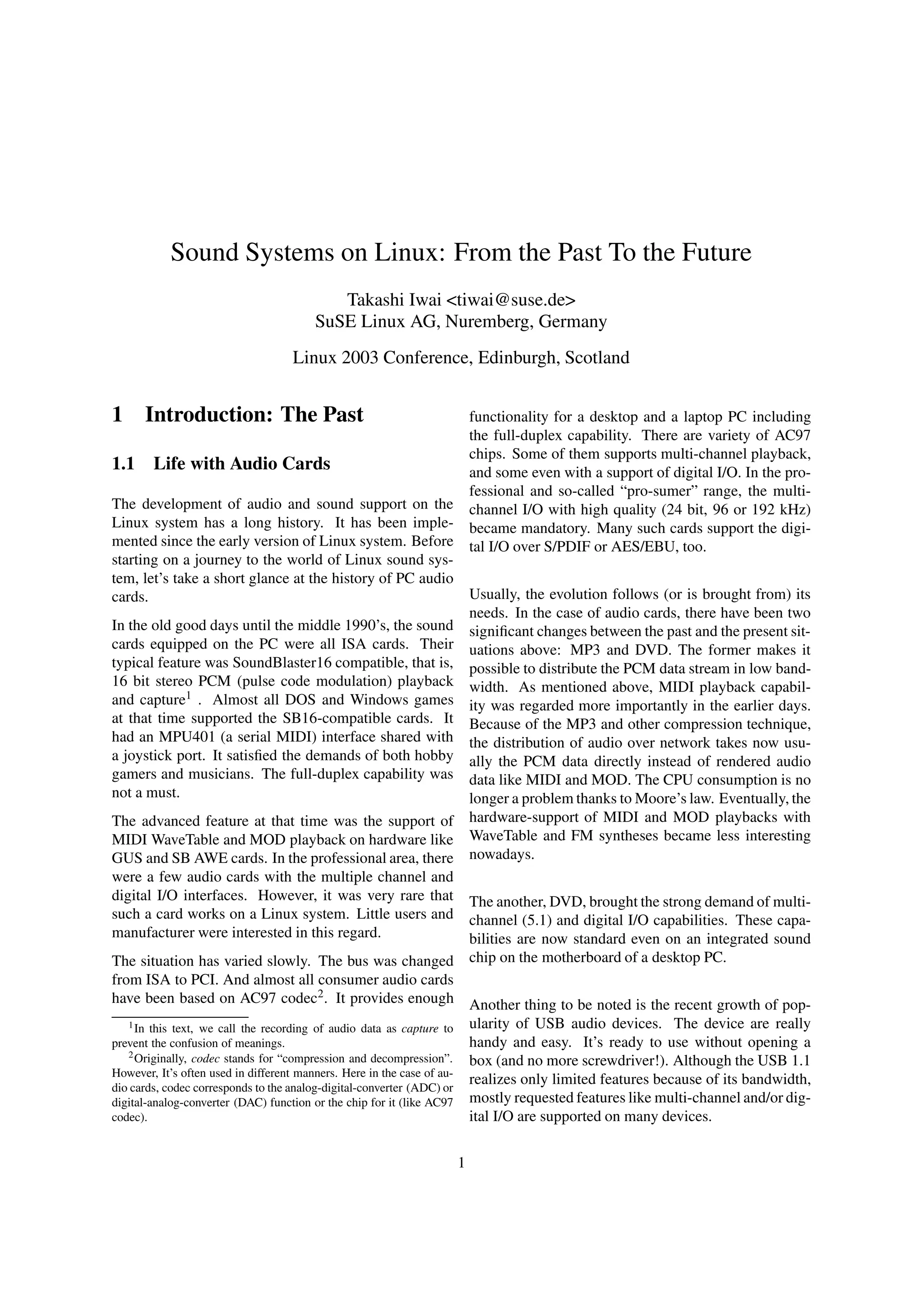
![1.2 Life with Linux
Now let’s back to the topic of our lovely Linux. In gen-
eral, there are two basic components which build the
sound system: the sound device driver and the sound
server. The former is the hardware abstraction in the
lower level, while the latter gives more high-end capa-
bilities like multiplex access and mixing. In other OS
like Windows, the boundary between these two compo-
nents is not clear. The driver does some heavy jobs like
mixing in the kernel, too. On the Linux system, how-
ever, these are regarded still separately. In the following
section, the sound drivers and the typical sound servers
in the past are explained briefly.
OSS
The core part of the sound system is the sound de-
vice drivers. On the Linux kernel, the OSS (Open
Sound System) drivers have been employed as the stan-
dard sound drivers. The OSS drivers — which were
originally written by Hannu Savolainen and formerly
called as different names like USS/Lite, VoxWare and
TASD — has currently two different versions. One is
the free software included in the recent standard Linux
kernel tree (OSS/Free) and another is the commercial
binary-only drivers distributed by 4Front Technologies
(OSS/Commercial)[1]. Both drivers have been evolved
in different directions, but both of them still have (al-
most) the API compatibility, based on the earlier ver-
sion of OSS.
The hardware support on the Linux system has been,
unfortunately, relatively poor in comparison with Win-
dows and MacOS. Some drivers were available only by
the OSS/Commercial version, especially for the new
cards and models. Positively looking, this means that
Linux users had at least some support for most of popu-
lar audio cards. However, on the other hand, they were
not free – in the sense of freedom, too. This situa-
tion has remained until recently, because many hard-
ware vendors didn’t like to provide the enough techni-
cal information to write a fully functional device driver
as the open-source.
The OSS provides a simple and easy API[2]. The API
was designed for the audio cards at the old ages, mainly
16bit two-channel playbacks and captures. The API fol-
lows the standard Unix-style via open/close/read/write
system calls. The memory mapping (mmap) is also sup-
ported, so that the audio data can be transferred more
efficiently. The mixer is represented as (up to 32) play-
back volumes, an input-gain, and a capture source se-
lector.
The applications are supposed to open and ac-
cess directly the device files, such as /dev/dsp or
/dev/mixer. The format and buffers are controlled via
specific ioctl’s. The raw MIDI bytes can be sent or re-
ceived via a raw MIDI device file. In addition, there is
a so-called “sequencer” device, which is used to handle
the MIDI events in the higher level with the sequential
timing control.
EsounD
Many sound cards support only one PCM stream for
each playback and capture, and the driver allows one
process to access it exclusively. That is, if you access
to a device from two or more applications at the same
time, only one application can run and others will be
blocked until it quits the operation. For solving this
problem, a sound server is introduced. Instead of read-
ing and writing a device file, applications access to a
sound server, which accesses to the device exclusively
on behalf. For multiple playbacks, a sound server reads
multiple PCM streams from several applications and
writes a mixed stream to the sound device (mixing func-
tion). For the capture direction, on the contrary, a sound
server writes the PCM streams from the device to any
accessing applications (multiplexing). Also, the sam-
ples being played by EsounD can be captured (loop-
back).
One of the commonly used applications for this pur-
pose is EsounD[3]. EsounD stands for the “Enlightened
sound daemon”. Lately, GNOME adapted this program
as its standard sound server, too.
EsounD provides the fundamental mixing and mul-
tiplexing capabilities of playback and capture PCM
streams. The PCM streams are read/written through
a simple Unix or TCP/IP socket. It is capable also to
communicate over network. A simple authentication is
implemented, too. The API is defined in libesd library,
which is a quite straight-forward implementation in C.
EsounD has many different audio I/O drivers not only
for Linux but also for other Unix systems. There are
2](https://image.slidesharecdn.com/soundsystemsonlinux-140414002344-phpapp01/75/Sound-systems-on-linux-2-2048.jpg)
![OSS and ALSA (described later) drivers for Linux, cur-
rently. However, only one of them can be built in at the
compile time.
aRts
KDE, a big competitor of GNOME, adapted another
program as its standard sound server. This server pro-
gram, aRts[4], was originally written as the “analog re-
altime synthesizer”. Obviously it was inspired by the
analog modular synthesizer system which was popular
in 1970’s. It consists of small basic components, and
each of them can be “patched” with cables. aRts uses
its own IPC method called MCOP for the patching in-
stead of real cables. MCOP is similar with CORBA but
much optimized for the data streaming (in fact, the ear-
lier version of aRts used CORBA). The audio data is
transferred over a Unix or TCP/IP socket.
As a sound server, aRts provides more ambitious fea-
tures than EsounD. In theory, any effects can be in-
serted by patching modules. Modules are implemented
as shared objects which are loaded dynamically onto
the server. aRts has also MIDI control capability. As
it’s based on the CORBA-like communication model,
aRts has also good network transparency.
The default language binding of aRts API is C++. Al-
though there is a C wrapper on the C++ binding, the
function is limited.
1.3 Always Problems in Life
Hard Life with OSS
As mentioned above, the OSS API is quite simple and
easy. In fact, there are many audio applications to sup-
port it. However, the “simple and easy” means, in other
words, that it doesn’t support high-end audio functions.
Namely,
1. The non-interleaved format3 is not supported.
2. Supported sample formats are limited.
3. It forces applications to access the device files di-
rectly.
3The format where the samples are placed separately in the dis-
crete buffer (or position) for each channel. That is, a group of mono
streams is handled as a single multi-channel stream.
4. The support of digital I/O is quite poor. IEC status
bits cannot be handled.
5. The mixer implementation is very limited.
The first two points lead to severe problems with the the
progress of audio cards. Although many modern cards
are capable to use such formats, the driver still can-
not handle them but only the traditional 16 bit 2 chan-
nel stereo format. Especially, the non-interleaved for-
mat is essential for many professional cards with multi-
channels.
The handling of sample formats is not as trivial as it
appears. Even a linear sample format can have different
styles depending on the byte order and the size. For
example, 24 bit samples can be packed either in 3 bytes,
4 bytes LSB or 4 bytes MSB. In addition, two different
byte-orders for each case. All they express the same
value!
The third point above might look not too critical. How-
ever, this is a serious problem if any pre- or post-
processing is required for the samples before sending
or after receiving them. A typical case is that the codec
chip supports only a certain sample rate, here 48 kHz
is assumed . For listening to a music taken from a CD,
the sample rates must be converted from 44.1 kHz. In
the OSS, this conversion is always done in the kernel
although such a behavior is regarded “evil”. This is be-
cause applications access to the device file directly, and
there is no room between the application and the driver
to process this kind of data conversion.
The fourth point is the problem appearing on the mod-
ern audio cards, too. The digital I/O interface transfers
often non-audio data streams like A52 (so-called AC3)
format. Many digital interfaces require the proper set
up of the IEC958 (S/PDIF) status bits to indicate sev-
eral important conditions such as the non-audio bit and
the sample rate. This information cannot be passed on
the OSS drivers in a consistent way.
The last point comes from the simplicity of mixer ab-
straction. For example, a matrix mixer, or a state-list el-
ement cannot be implemented with the standard mixer
API. The only solution for such a non-standard thing is
to use a private ioctl.
Pain with Sound Servers
Introducing a sound server solves some of the problems
above. For example, the sample rate conversion should
3](https://image.slidesharecdn.com/soundsystemsonlinux-140414002344-phpapp01/75/Sound-systems-on-linux-3-2048.jpg)
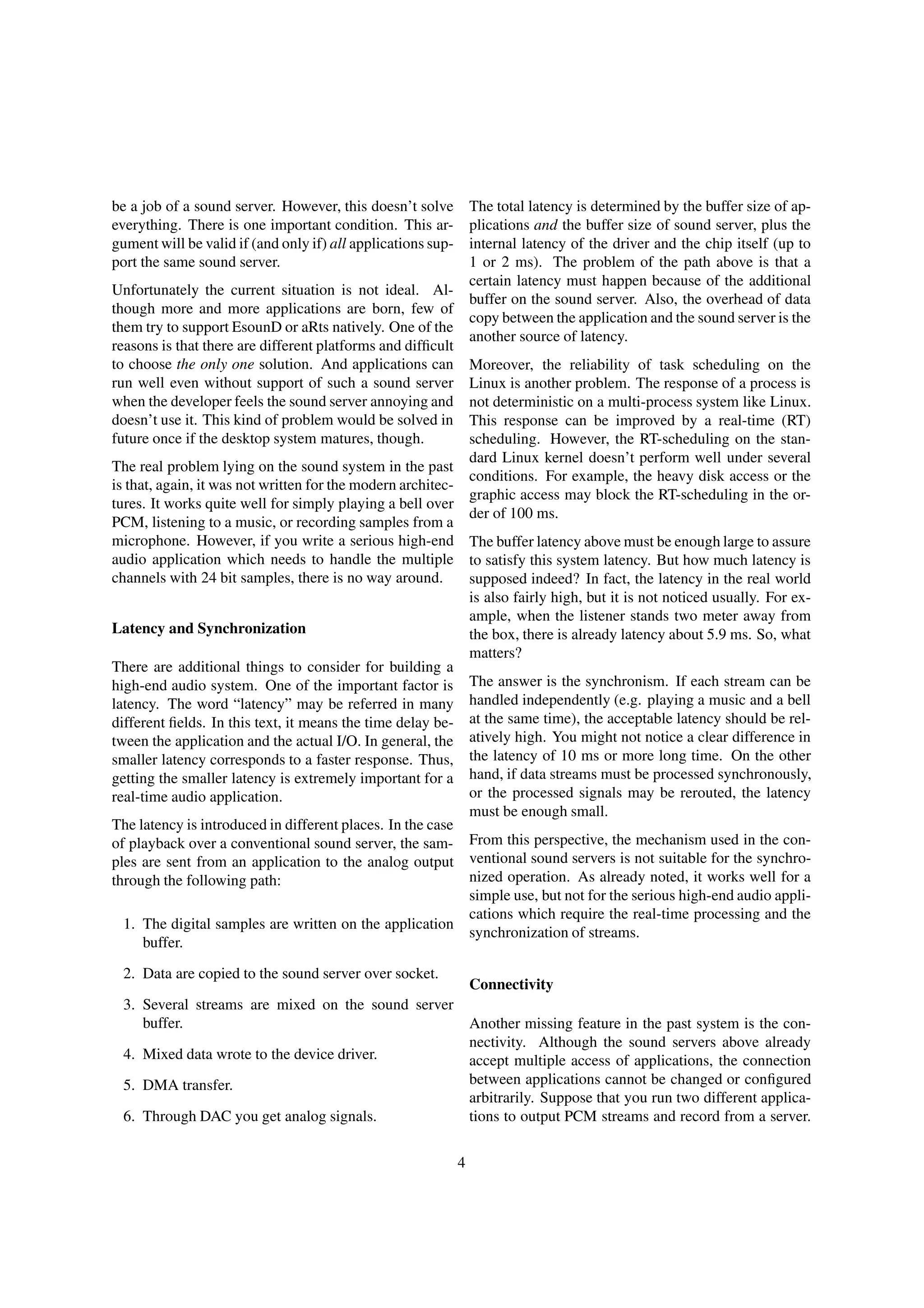
![With the past server systems, you cannot switch the
connections on the fly.
The same situation can be found in the area of MIDI.
The MIDI streams are not handled properly by the
sound servers, too. The multiplex access and the dis-
patching are missing in the conventional system.
And the last missing connectivity is the connection of
people. Each project and each audio application was
developed independently in most cases, and they were
rarely involved with each other.
1.4 Back To The Future
For the better support of audio hardwares, a new sound
driver project was started by Jaroslav Kysela and oth-
ers. The firstly supported card was Gravis UltraSound
card only. Lately the project targeted the general sup-
port of other cards and was renamed “Advanced Linux
Sound Architecture” (ALSA)[5]. The functionality of
ALSA has been constantly improved. The range of
sound cards supported by ALSA has become always
wider including many high-end audio cards. The ALSA
drivers were integrated into the 2.5 kernel tree officially
as the next standard sound drivers.
The situation around the system latency of Linux kernel
gets improved with the recent development. Andrew
Morton’s low-latency patchset[7] and Robert Love’s
preemption patchset[8] solved the scheduler-stalling
problem significantly. In the 2.5 kernel series, the lat-
ter was already included, and the codes were audited to
eliminate the long stall in many parts. With the tuned
Linux kernel, it’s even possible to run the audio system
in 1 or 2 ms latency[9].
The change happens also in the community. There have
been more and more active communications and dis-
cussions over the mailing list. Some hardware vendors
have been involved with the development of ALSA, too.
The most important results are LADSPA (Linux audio
developer simple plugin API) plugins[10] and JACK
(Jack Audio Connection Kit)[12]. Both were born and
shaped up from the discussion on the Linux audio de-
veloper mailing-list[6].
LADSPA is a plugin API for general audio applications.
It’s very simple and easy to implement in each audio
application. There are many plugins for every effect
(most of them are written by Steve Harris[11]).
The latter, JACK, is a new sound server for the pro-
fessional audio applications. JACK was primarily de-
veloped by Paul Davis, and employed as the core au-
dio engine of ardour, a harddisk recorder program. It is
based on the completely different design concept from
the conventional Linux sound servers. It is aimed to
glue the different audio applications with the exact syn-
chronization. Together with the ALSA and the low-
latency kernel, JACK can run in a very short latency.
The number of applications supporting JACK has been
growing now.
Finally at this point, we are back to the present stage.
In the following sections, the implementation and tech-
nical issues of ALSA, JACK and other projects related
with the sound system are described.
2 ALSA
2.1 Characteristics of ALSA
ALSA was designed to overcome the limitation of exist-
ing sound drivers on Linux. In addition to the support of
high-end audio cards, the ALSA was constructed with
the following basis:
• Separate codes in kernel- and user-spaces
• Common library
• Better management of multiple cards and multiple
devices
• Multi-thread-safe design
• Compatibility with OSS
Fig. 1 depicts the basic structure of ALSA system and
its data flow. The ALSA system consists of ALSA
kernel drivers and ALSA library. Unlike the OSS,
ALSA-native applications are supposed to access only
via ALSA library, not directly communicating with the
kernel drivers. The ALSA kernel drivers offer the ac-
cess to each hardware component, such as PCM and
MIDI, and are implemented to represent the hardware
capabilities as much as possible. Meanwhile, the ALSA
library complements the lack of function of the cards,
and provides the common API for applications. With
this system, the compatibility can be easily kept even
5](https://image.slidesharecdn.com/soundsystemsonlinux-140414002344-phpapp01/75/Sound-systems-on-linux-5-2048.jpg)
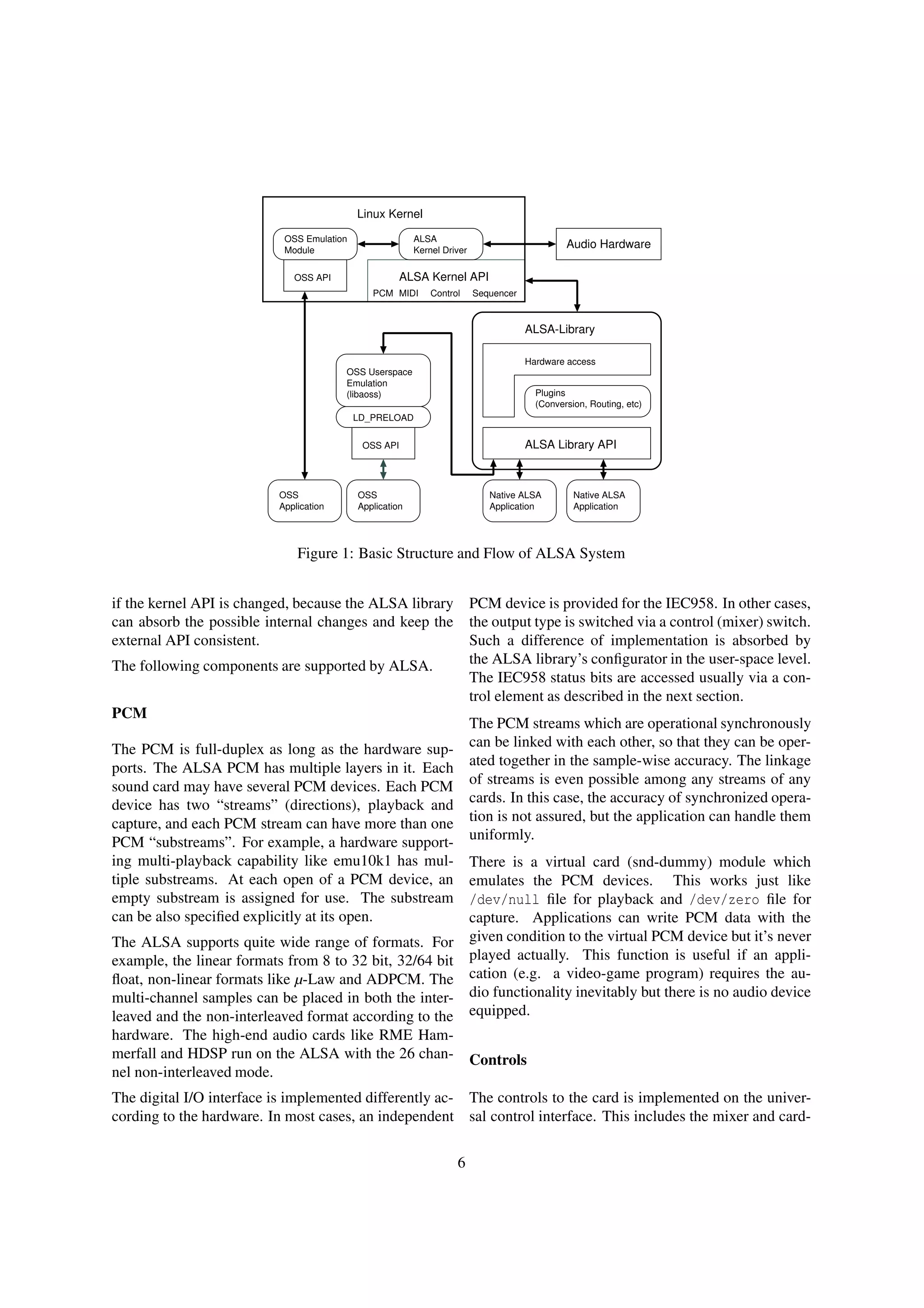
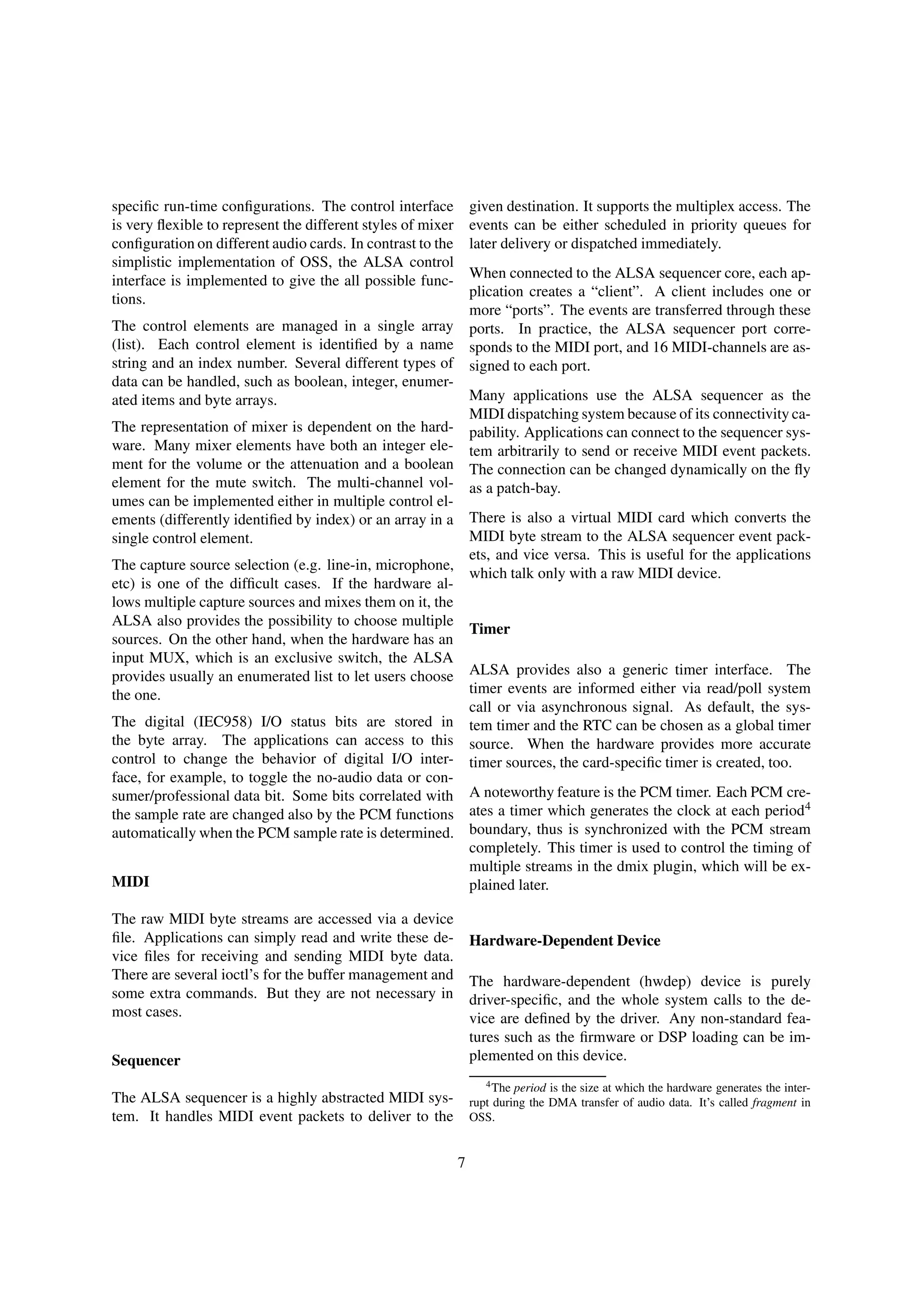
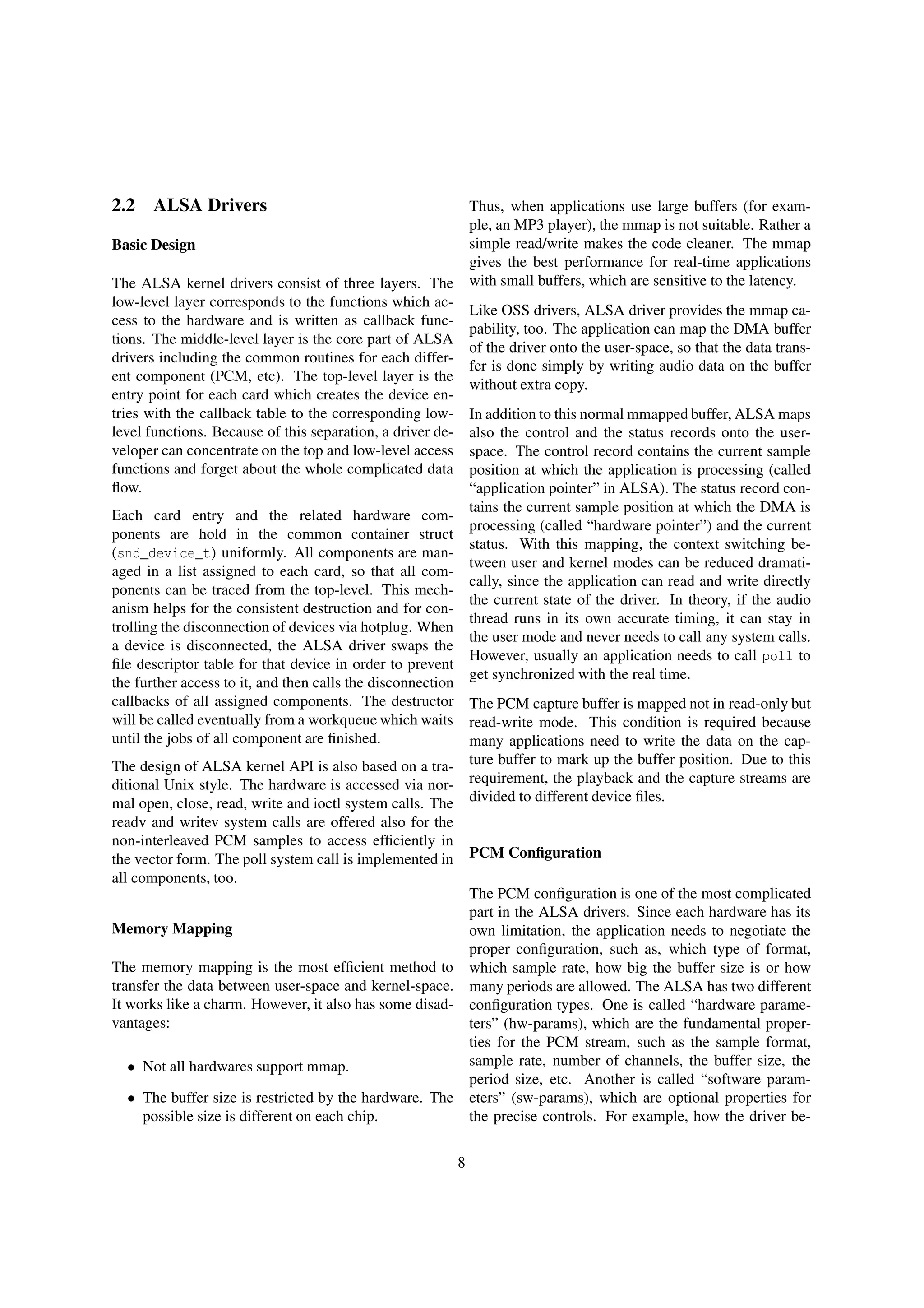
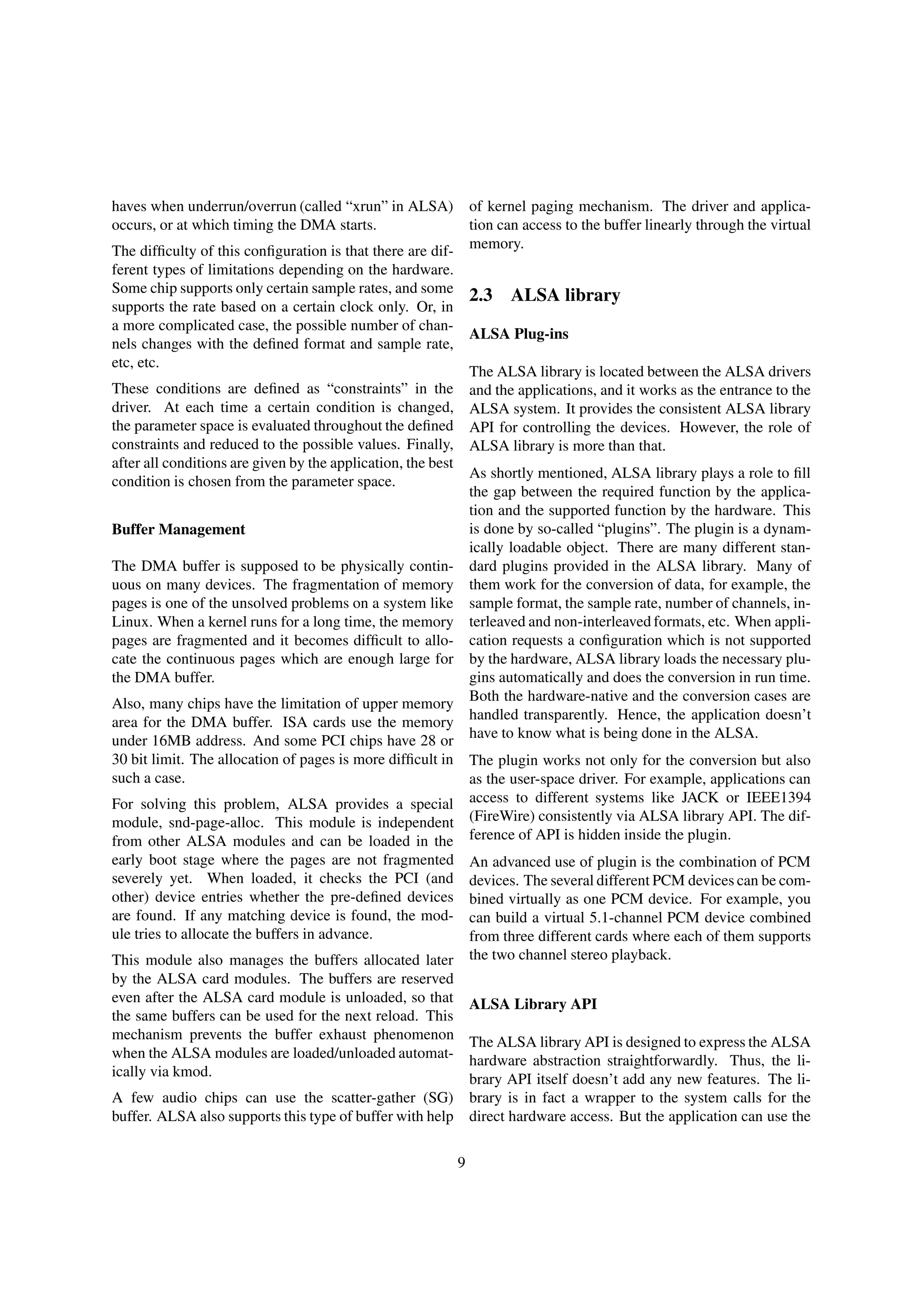

![model. This is another programming paradigm in com-
parison with the traditional Unix style model. In this
model, each audio processor (called “client” in JACK)
is executed passively at the moment when the audio
data must be handled on the buffer immediately. For
the playback, the callback is invoked when the audio
data is to be filled on the buffer. For the capture, the
callback is invoked when the audio data is ready to read
from the buffer.
On the system based on the traditional style, each ap-
plications read or write whenever they want. Thus, the
audio streams are handled without synchronization. In
the case of callback model, on the contrary, the syn-
chronization of data-flow is assured in the sample-wise
accuracy since the timing to call each callback is de-
termined by the server. The same strategy is taken
in other modern audio systems like CoreAudio[13] or
ASIO[14].
JACK handles only the 32bit float as its audio data
unlike the other conventional sound servers. Also, it
assumes only the non-interleaved format, i.e. mono
streams for multi channels. These differences may
make the porting of existing audio applications a bit
harder, in addition to the difference of programming
style described above.
Basic Structure
Fig. 2 shows the basic flow diagram of the JACK sys-
tem. There is a JACK server daemon running as a cen-
tral sound server, and each application accesses to the
JACK server as a client. A client has several ports, and
the connection between ports are flexible and can be
changed on the fly. This concept is quite similar with
the ALSA sequencer.
The JACK sound server communicates with the sound
engine (e.g. the sound driver) exclusively as well as
other sound server systems. The JACK supports sev-
eral platforms for the sound engine. In addition to the
ALSA, PortAudio[15] and Solaris drivers are imple-
mented currently.
JACK has two different types of clients: internal and
external clients. The internal client is a kind of plugin.
It’s a shared object running inside a JACK server. On
the other hand, the external client is a thread running
independently. This multi-thread communication is the
advanced and unique feature of JACK, which is not seen
in CoreAudio or ASIO.
JACK
server
daemon
ALSA
External
JACK
client
Internal
client
Internal
client
External
JACK
client
External
JACK
client
Internal
client
JACK API
ALSA API
Figure 2: JACK flow diagram
Being executed in a server process, the internal client
runs without context switching, and thus it’s more ef-
ficient than the external client from the perspective of
performance. For the development perspective, an ex-
ternal client is easier to develop and debug, because it
is in fact a part of the application. Also, it’s more tough
against the unexpected program failure.
The data transfer in JACK is very efficient. Basically,
JACK tries to implement the “zero-copy” data trans-
fer. The JACK server runs in the mmap mode for the
data transfer between JACK server and the ALSA. The
audio-data buffer between a JACK server and a JACK
client is shared via the IPC shared memory. Only the
control messages are communicated through FIFO of a
normal socket.
In the callback model, each JACK client is executed as
an FIFO sequentially. The execution path of clients fol-
lows the connection graph. When a client callback is
called, it reads the data from the JACK server or another
client, processes it, then writes to the next. With this
style, the change of the graph connection/disconnection
can be handled more easily.
JACK API
JACK provides a highly abstracted API for the au-
dio applications. It’s very simple and dedicated to
the callback-style programming. Since the low-level
configuration for the audio driver is determined in the
JACK server level, JACK clients don’t have to deal with
such a subtle thing. Instead, each client needs to con-
centrate on the creation, destruction and connection of
11](https://image.slidesharecdn.com/soundsystemsonlinux-140414002344-phpapp01/75/Sound-systems-on-linux-11-2048.jpg)
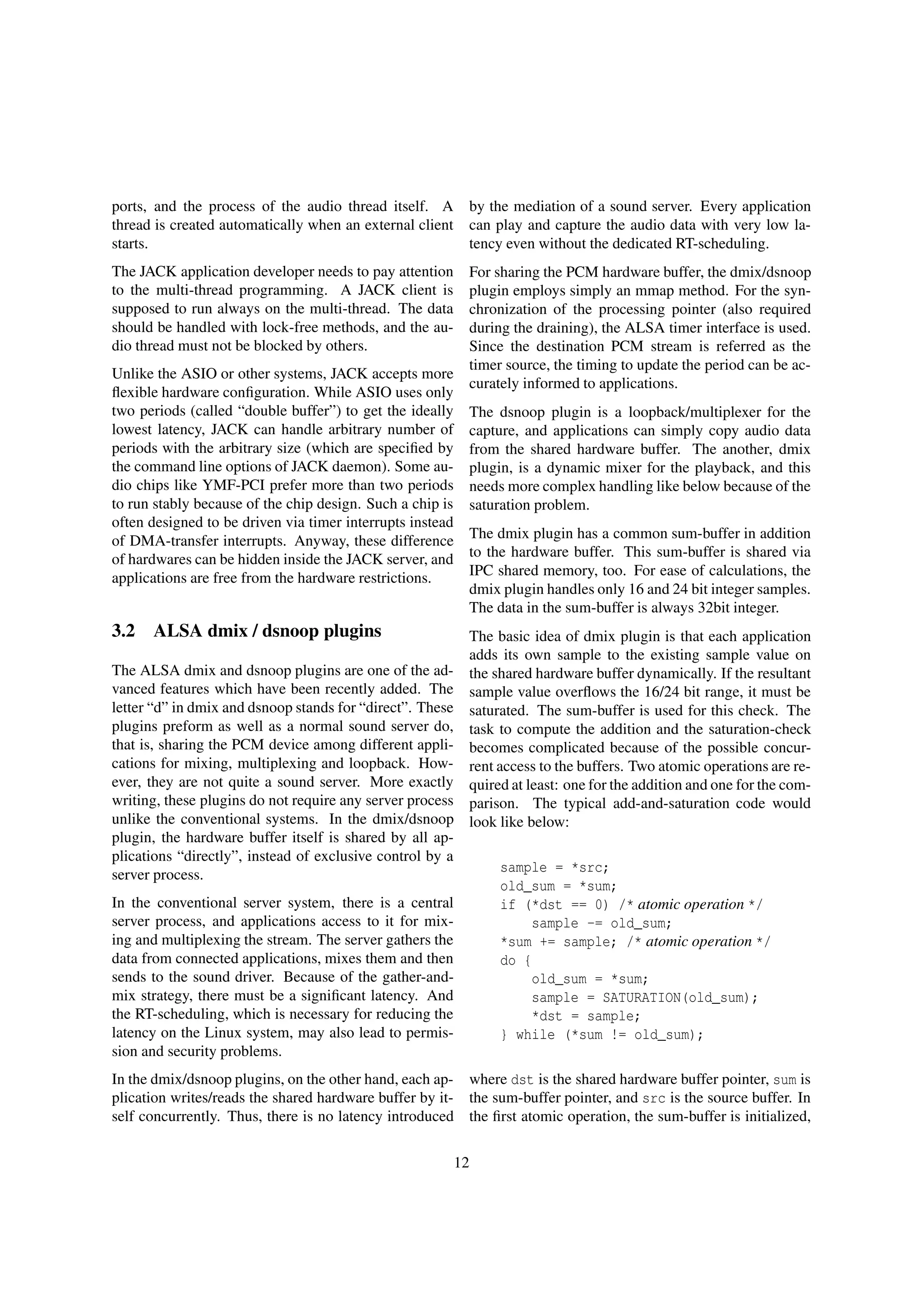
![and then the current sample is added on the sum-buffer.
The succeeding do-while loop performs the saturation
and the substitution to the hardware buffer.
The demerit of the dmix plugin is that this lock-free
algorithm is more expensive than the implementation
in the server-client model. Also, because of the atomic
operations, it’s not implemented on all architectures yet.
Another note is that the dmix/dsnoop plugins are not
designed for the arbitrary connections. They are pro-
vided as an alternative to the simple sound server. Al-
though the CPU consumption of dmix plugin is higher
than the others, these plugins are promising for normal
consumer purposes, because the ALSA applications can
run through these plugins without rewritten at all.
3.3 Other Projects
The sound servers for the network system is still an
open question. For the generic sound server belongs
to the traditional style like EsounD and aRts, there is a
new project, MAS (media application server)[16]. The
design of MAS is similar with the conventional sound
servers, based on the open/read/write model. It is a
modular system like aRts. The advantage of MAS is
its tight binding with the X server. The MAS supports
several different protocols for the remote data transfer.
The protocol can be chosen depending on the network
condition. In the worst case, the data can be even tun-
neled through the X protocol.
Since MAS is still under heavy development, it’s still
too early to evaluate the performance with other ad-
vanced systems. However, this looks like a good so-
lution for the environment with many machines con-
nected over a LAN.
Another interesting system having the similar concept
is GStreamer[17]. This is aimed to achieve a universal
platform for the whole multimedia including both video
and audio. The system is monolithic and each module is
implemented as a plugin shared object, as well as many
other systems. There are large number of modules al-
ready available on GStreamer.
In the area of the broadcasting of audio (and video)
streams, a promising project is Helix DNA[18]. This
is a collaboration work between the open-source com-
munity and the big player like RealNetworks. Its aim
is to provide the comprehensive cross-platform for the
boradcasting system, including its standard API and the
client/server applications. The project is still in the
early development stage, and the support of ALSA is
not finished yet.
There are so many different things for the single theme
— the sound system. And you might have the ques-
tion: Which platform should we choose? This is, in-
deed, a very difficult question to answer. The key for
the possible solution is to define a portable API. The
PortAudio[15] is a good candidate for this. It supports
very wide range of OS and sound systems (including
both ALSA and OSS) with the same consistent API.
PortAudio provides both the traditional and the callback
style APIs. Thus, it can be a suitable solution to melt the
solid gap between the different architectures like JACK
and OSS.
4 The Future: a.k.a. TODO
4.1 Problems of ALSA
Now, let us take a look at the current problems and what
will (or should) happen in the future. Regarding to the
ALSA, first of all, what should be done is to improve its
usability. The current ALSA is full of complexity.
There have been many rumors that the ALSA is
so difficult to set up compared with the OSS. It’s
partly true — there are more configurations (e.g. in
/etc/modules.conf) necessary to make the system run-
ning properly (although such settings are not always re-
quired if one runs only ALSA native applications). In a
convenient future, such a problem will disappear when
all the major distributors support ALSA primarily.
Besides, there are still more things to consider in this re-
gard. The ALSA is a hardware abstraction. The ALSA
covers the hardware capability as much as possible.
This policy sometimes leads to the too complex repre-
sentation. For example, some chips show hundreds of
controllable mixer elements, and it’s of course too much
for end-users. More higher abstraction is needed for the
more intuitive usage.
Also, there is no user-friendly editor for the ALSA con-
figuration files, and no enough example configuration
files provided. There is no good way to set up the
IEC958 status bits, too. This situation tends to prevent
the user to try the advanced features, unfortunately.
13](https://image.slidesharecdn.com/soundsystemsonlinux-140414002344-phpapp01/75/Sound-systems-on-linux-13-2048.jpg)
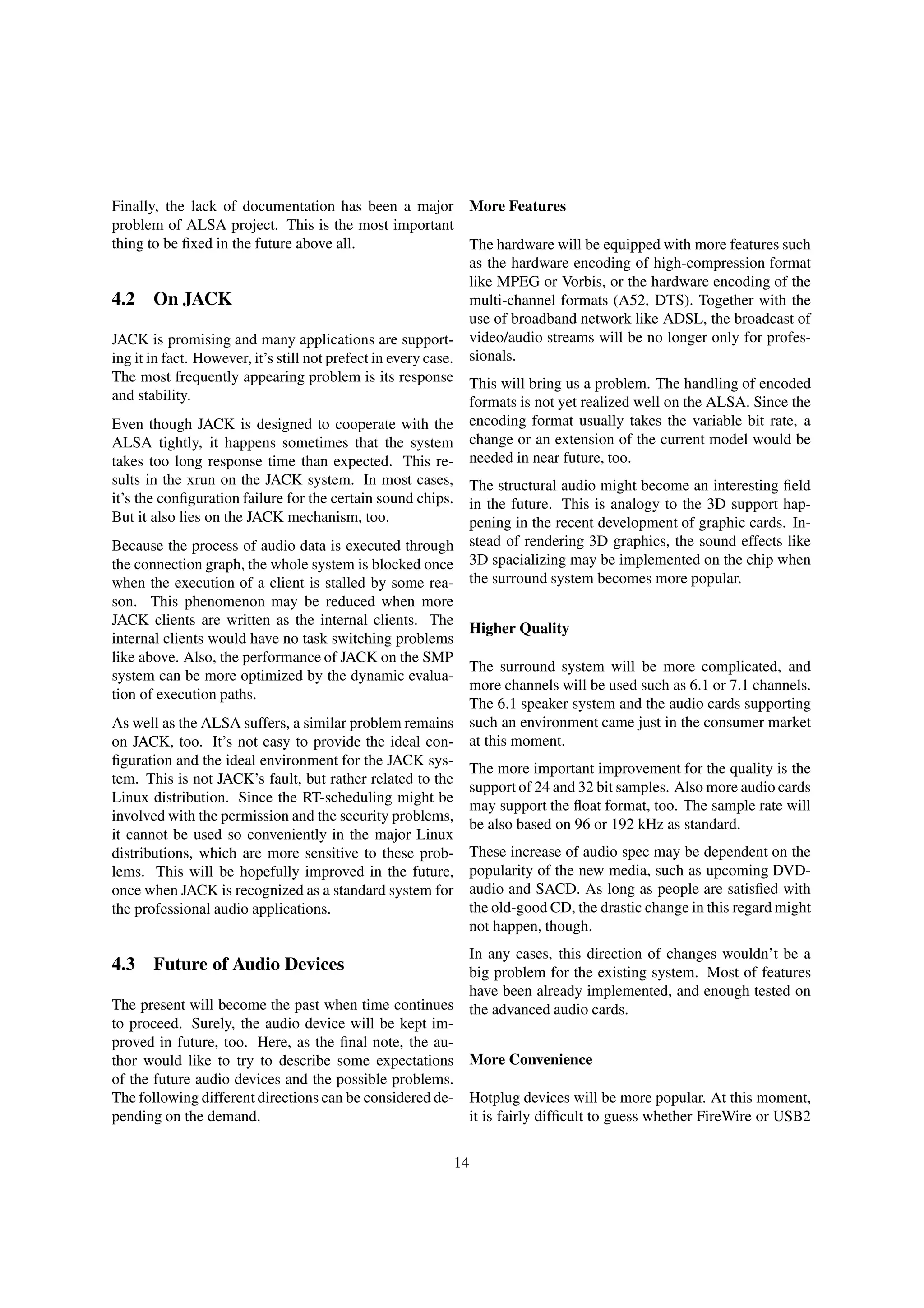
![dominates. But both specs are enough high to replace
the existing PCI audio cards. In the future, only the on-
board (integrated) audio chip and the hotplug devices
might remain in the market.
From the viewpoint of Linux system, this would require
the better support of user-space drivers. This implies the
reliable kernel scheduling to assure the exact timing for
the isochronous transfer on user-space.
References
[1] 4Front Technologies, OSS/Commercial home-
page: http://www.opensound.com
[2] 4Front Technologies, OSS programmers guide,
v1.1: http://www.opensound.com/pguide/
oss.pdf
[3] EsounD project homepage: http://www.tux.
org/~ricdude/EsounD.html
[4] aRts project homepage: http://www.
arts-project.org
[5] ALSA project homepage: http://www.
alsa-project.org
[6] Linux Audio Developers (LAD) mailing-list
homepage: http://www.linuxdj.com/audio/
lad/
[7] Andrew Morton, low-latency patchset for 2.4 ker-
nels: http://www.zip.com.au/~akpm/linux/
schedlat.html
[8] Robert Love, preemptive patchset: http://www.
tech9.net/rml/linux/
[9] Resources about low-latency at LAD site:
http://www.linuxdj.com/audio/lad/
resourceslatency.php3
[10] Richard Furse, Linux Audio Developer’s Simple
Plugin API (LADSPA) homepage: http://www.
ladspa.org/
[11] Steve Harris, SWH Plugins: http://plugin.
org.uk/
[12] JACK project homepage: http://jackit.sf.
net
[13] Apple Computer Inc., CoreAudio: http:
//developer.apple.com/audio/coreaudio.
html
[14] Steinberg, ASIO developer information area:
http://www.steinberg.net/en/ps/support/
3rdparty/asio_sdk/
[15] PortAudio homepage: http://www.portaudio.
com/
[16] MAS project homepage: http://www.
mediaapplicationserver.net
[17] GStreamer project homepage: http://www.
gstreamer.net/
[18] Helix Community homepage: https://www.
helixcommunity.org/
15](https://image.slidesharecdn.com/soundsystemsonlinux-140414002344-phpapp01/75/Sound-systems-on-linux-15-2048.jpg)